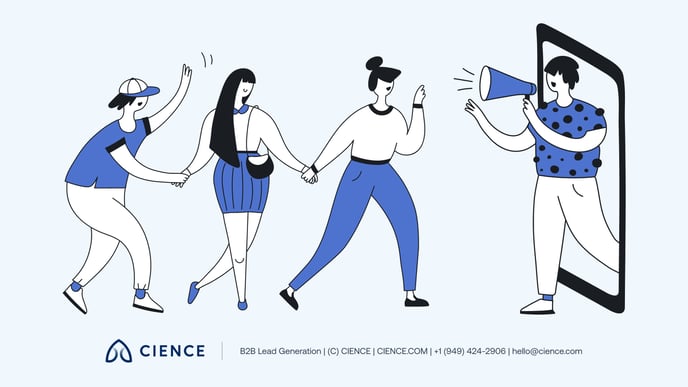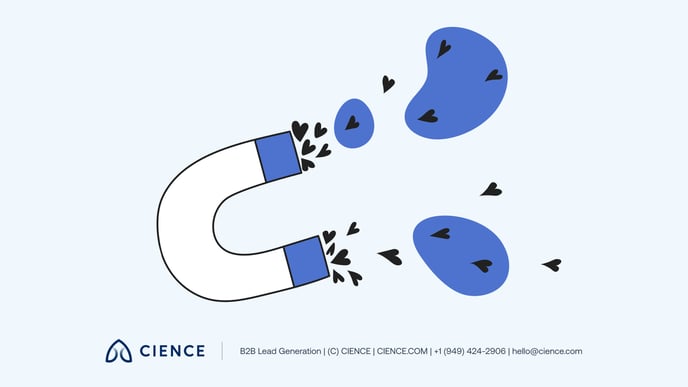B2B Lead Nurturing Guide: Best Practices to Turn Leads into Customers
You’re doing everything right: Your researchers find top-quality contacts, salespeople do a great job of converting them into customers, inbound channels attract interested leads, and yet it seems a lot of leads slip through your fingers. How so?
Contacts travel a long way from being a lead to becoming a customer, and naturally, some of them are not ready to buy regardless of what funnel stage they are in. B2B sales cycles are long, and businesses have a lot on their plate. How can you stand out from your competitors to land new customers with minimal investments?
Two words: lead nurturing.
Essentially, lead nurturing is about creating a bond with your leads and giving them value over and over again. This means showing them that you care, that you can change their business for the better, and most importantly, that you are ready to wait until they are ready to purchase.
Let’s find out how to nurture leads, what goes into the lead nurturing process, and the best strategies for your success.

What Is Lead Nurturing?
Lead nurturing by definition is the process of developing and maintaining a relationship with your existing, potential, and past customers. It creates a connection between a lead and brand by providing value and support in a delightful and personalized way.
This process can use various channels like email, digital marketing, ads, or even direct mail. An essential component of lead nurturing is content, as it has to target specific buyer personas and relate to the needs of the addressees.
Lead nurturing takes time, and it is not about immediate sales. It’s about keeping your brand image fresh in your audience's memory, serving their needs, and someday maybe serving them as your customers.
Why Is Lead Nurturing Important?
Did you know that 96% of your website visitors aren’t ready to buy yet, while 80% of new leads you get may never translate into sales? If you are willing to make the most out of your resources and up your sales game, then lead nurturing is the way to go.
However, don’t think that B2B lead nurturing will cure all your problems in a second. Think of it like vitamins: If you start taking them now, you’ll likely feel better in a month or so.
While sales cycles grow longer, lead nurturing ensures that time is not a barrier for your sales but rather a platform to build loyalty and trust in these ways:
1. Nurturing your leads showcases your value.
Lead nurturing is all about giving. You serve your leads with value, value, and value. You nurture them with relevant marketing materials that speak to their needs, therefore giving them a preview of what hiring you would be like.
Prospect nurturing shows how your company can enhance business processes, yet it plays the long game. It’s not about asking, “Will you purchase right now?” but instead saying, “Look what we can do for you in the future.”
2. Sales nurturing boosts your KPIs.
The equation is simple with sales nurturing: It’s supposed to cost you less and bring you better results. It increases engagement rate, conversion rate, customer retention rate, reduces marketing costs, and boosts ROI with minimal investments.
3. Nurturing increases your brand awareness.
Before a lead becomes a customer, they have to be aware of your company name, what you do, how you stand out from your competitors, and how you can make their life easier. B2B lead nurturing is a way to raise brand awareness and make your sales cycle a bit shorter.

How Does the Lead Nurturing Process Work?
We’ve established the importance of lead nurturing; now let’s step into the mechanisms of this process. Every lead nurturing campaign is unique based on its type (email, direct mail, landing pages, etc.) and the goals you want to achieve (re-engage past customers, generate sales leads, present new tools or services).
The B2B lead nurturing process has at least three constant components:
1. Contacts
First, start by choosing leads you want to nurture. They can come through inbound channels, or they may not have been ready to purchase during your previous outbound engagements. Either way, you can group the leads by buyer personas and engage them in a B2B lead nurturing campaign.
2. Content
No matter what channel you use for sales nurturing, content plays a significant part in its success. You can actively use your marketing department for this stage: Blogs, whitepapers, landing pages, and case studies are all among the materials that can engage your audience and show how your thought leadership can modernize their business processes.
Tip: If you’re a company with many new products or services coming out, or you constantly get public recognition, email newsletters can be a great way to share that with the audience you nurture.
3. Completion
Lead nurturing will work best when done regularly and cleanly. For that, you might want to look into the functions of your CRM automation software. It will take a workload off your salespeople and bring your sales and marketing efforts together.
Lead Nurturing Campaign: Creating a Checklist
Though 74% of companies say converting leads into customers is their top priority, many of them disregard prospect nurturing and lose valuable opportunities. To make the process of starting your first lead nurturing campaign easier, create a checklist of tasks you need to do to make it right.
1. Build lead lists.
You probably already have dozens of leads that are not ready to buy and just hang in your sales funnel. You should find them, define where they are in the funnel, and group them by categories (firmographics, stage of the funnel, location, industry, etc.) Segmenting your audience won’t be much trouble if you keep your database clean from duplicates and old contacts.
2. Choose the type of campaign.
The most popular type of lead nurturing campaign is through email. However, there are plenty of other choices: Direct mail will be more effective for small businesses, ad campaigns for broader audiences, while social media can be a part of a cross-channel nurture campaign.
3. Define the complexity.
Just like with lead generation campaigns, you have to plan a lot of the details ahead of your start. Since you will target leads that already know your brand, you’ll need to define how long the campaign will last, how many touches you should have, and how much time should pass between the waves of your outreach.
4. Prepare the content.
The type of campaign will determine the length and format of the content you need to create. While landing pages and ads need to be crafted specifically for each campaign, lead nurturing through email can utilize the content your writers have already created for your website (guides, whitepapers, tutorials, case studies, or even press releases).
No matter what form of content you choose, you should fill it with authenticity and value.
5. Use automation.
There is no specific software for lead nurturing, but a good CRM will be able to cover most of your needs. In a CRM, you’ll be able to schedule outreach, adapt it to the needs of your audience, and track its effectiveness and the impact it has on other lead generation processes.
If you want to know more about marketing automation, we have detailed articles on the best CRM tools and CRM migration.
6. Analyze, optimize, and start again.
The key to success is repetition. After you’re done with your first sales nurturing campaign, you should track every KPI at your disposal. Did your conversion rate rise? Or did your engagement on social media drop a bit? Based on those parameters, you can figure out what your audience responds to, what went wrong and needs fixing, and what techniques you can A/B test in the future.
Best Practices for Lead Nurturing
Use these lead nurturing strategies to help you achieve the best results:
1. Embrace your audience.
Synonyms for “nurture” are: cherish, care, cultivate, educate, nurse, and support. And this is precisely what you are supposed to be doing with your B2B leads.
Customers tend to choose what’s best for their business, but they also consider relationships, meaningful connections, and good service. Lead nurturing is a way to show that you care and can provide all of the above.
2. Choose multichannel outreach.
You can choose any channel for your lead nurturing campaign, but just like with lead generation, we recommend the multichannel approach. It increases customer retention rates, brand awareness, creates a complete customer journey, and enhances customer-buyer relationships.
However, make sure your multichannel outreach is thoughtful and not overwhelming; you don’t want to put too much pressure on your leads.
3. Use lead scoring.
Lead scoring is a method of evaluating each lead you get based on various categories: level of engagement, company size, sales funnel stage, etc. Each lead receives a score that shows which leads have to be prioritized and contacted right away, and those that need more nurturing.
Lead scoring will help you correctly segment your audience by groups and focus your attention on the most urgent matters.
4. Use interactive content.
Interactive content is all over outbound lead generation trends, and it won’t go anywhere, anytime soon. It generates twice as many conversions as passive content because it catches the eye and engages the audience. You can use anything from GIFs and videos to emojis and quizzes. Plus, it’s fun!
5. Nurture after the purchase.
Once the purchase is settled, many brands relax and ease up on the nurturing, which is not the right tactic to use. You should keep supporting your customers to gain their loyalty. In fact, retaining an existing customer will cost you five times less than getting a new one.
So, your value should always be on the table.

Lead Nurturing for B2B Strategies
Implementing a B2B lead nurturing campaign can have a significant impact on your lead generation efforts. It helps you connect with your audiences, close more deals, maximize ROI, enhance customer loyalty and retention, and make your leads feel heard.
Getting new leads is a proven way to grow your business, but nurturing the ones you already have into becoming paying customers can be the boost you need to take your sales to new heights.
A Few (Related) Sales Posts
 Featured image: 5 Impactful Ways to Use Videos for Lead Generation - Read full post: 5 Impactful Ways to Use Videos for Lead Generation
Featured image: 5 Impactful Ways to Use Videos for Lead Generation - Read full post: 5 Impactful Ways to Use Videos for Lead Generation
5 Impactful Ways to Use Videos for Lead Generation
 Featured image: Best Lead Management Software - Read full post: 15 Best Lead Management and Tracking Software for 2024
Featured image: Best Lead Management Software - Read full post: 15 Best Lead Management and Tracking Software for 2024
15 Best Lead Management and Tracking Software for 2024
 Featured image: What Is B2B Lead Generation? The Ultimate Guide - Read full post: The Ultimate Guide to B2B Lead Generation: Strategies, Channels, and Tools
Featured image: What Is B2B Lead Generation? The Ultimate Guide - Read full post: The Ultimate Guide to B2B Lead Generation: Strategies, Channels, and Tools



